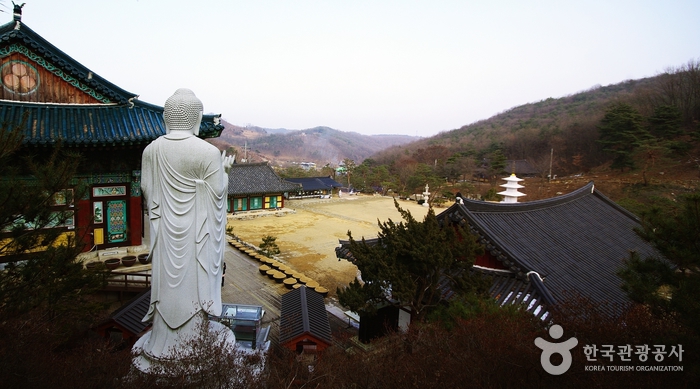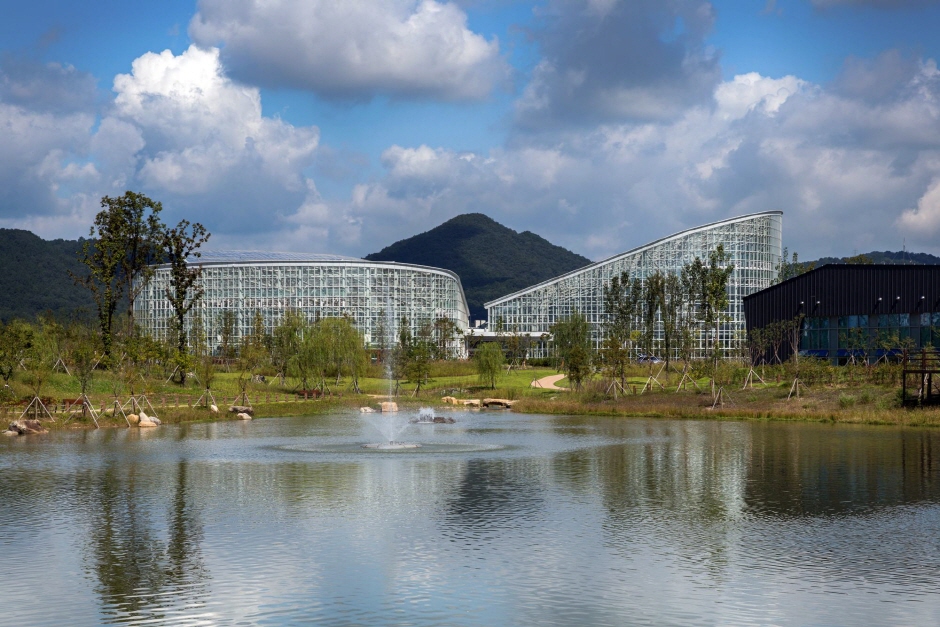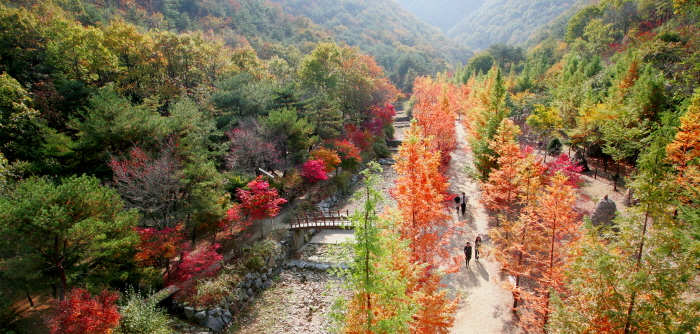Pont piéton Geumgang (금강보행교)
16.3Km 2023-01-04
Sejong-ri, Yeongi-myeon, Sejong (세종특별자치시 연기면 세종리)
Le pont piéton Geumgang désigne un nouveau lieu touristique à Sejong. Ouvert en mars 2022, il s'agit du premier pont à deux étage de Corée. Doté d'une architecture circulaire, le pont offre de nombreuses choses à voir. La partie supérieure du pont est réservé aux piétons alors que la partie inférieure est réservée aux cyclistes.
Hotel The H [Korea Quality] / 호텔 더 에이치(Hotel The H, 더 에이치) [한국관광 품질인증]
16.4Km 2023-04-13
58, Sintanjindong-ro 23beon-gil, Daedeok-gu, Daejeon
+82-42-932-0005
Hotel the H is a business hotel located 300 meters from the Sintanjin Station in Daejeon. Offering reasonable rates and high-quality service, the accommodation suits not just business trips but casual travels as well. The 32 rooms are categorized into standard, twin, and pent rooms. Standard rooms are for one person or more, whereas pent rooms are for 6-8 persons. In the pent room, barbeque, camp fire, or cooking is allowed. It also has its own terrace and swimming pool, making the room suitable for office or family gathering. Complimentary breakfast (consisting of toast, cereal, various instant noodles, rice, coffee, juice, and milk) is provided at the cafe on the first floor for all guests. Breakfast is offered until 10 a.m. and the place is operated as a cafe during the rest of the day. Next to it is a business center with shared PCs and a printer. A twenty-minute walk away from the hotel is Geumgang Lohas Eco Park with the Geumgang River, which is a nice place for a stroll in the morning or evening. The hotel has a room for the disabled as well.
Temple Yeongpyeongsa (영평사)
16.8Km 2021-10-27
441, Sanhak-ri, Janggi-myeon, Gongju-si, Chungcheongnam-do
+82-44-857-1854
Le temple de Yeongpyeongsa est une branche du temple de Magoksa, le 6ème temple local de l’ordre de Jogyejong. Il abrite six bâtiments traditionnels et trois petits hermitages. La montagne Janggunsan, où le temple est situé, est petite de par son envergure mais elle est réputée pour son côté énergisant. Selon les principes du Feng Shui, la montagne constitue un emplacement parfait pour accueillir un temple, car elle prend la forme d’un dragon enroulé le long de la rivière Geumgang.
Yeongpyeongsa est un endroit tranquille, qui personnifie la pureté des pratiques bouddhistes du temple, avec un air frais et une eau pure qui forment un habitat pour les lucioles, les écrevisses et les escargots noirs. En chemin, les visiteurs sont accueillis par une multitude de fleurs sauvages rivalisant pour attirer l’attention : les ancolies et les pulsatilles au printemps, les lotus blancs en été et les chrysanthèmes sibériens en automne.
centre d'art BOK (비오케이아트센터)
17.2Km 2023-01-18
12, Gukchaegyeonguwon 3-ro, Sejong-si
Le centre d'art BOK se situe à Bangok-dong dans la ville de Sejong-si. Ce centre a ouvert ses portes en 2019. Le centre abrite une salle de spectacle où se déroulent divers événements, une galerie pour l'organisation des expositions, l'espace Hobby factory (magasin de figurines et objets de décoration), des cours de pâtisserie CCUME où vous pourrez apprendre la pâtisserie, une librairie et un café.
Maison Myeongjae[Korea Quality] (논산 명재고택 [한국관광 품질인증])
17.3Km 2023-04-13
50, Noseongsanseong-gil, Noseong-myeon, Nonsan-si, Chungcheongnam-do
+82-41-735-1215, +82-10-6310-1139
Located in Noseong-myeon, Nonsan-si, Chungcheongnam-do, Myeongjae Historic House was built by Yun Jeung (pen-name: Myeongjae, 1629-1714), a scholar during the reign of King Sukjong (r. 1674-1720) of the Joseon Dynasty. It is said that although the king granted him a government post on eighteen occasions, Yun, being a straightforward sort of person, declined them all. As he practiced the virtue of simplicity and sharing in life and taught it to younger generations, the house escaped destruction during the Donghak Peasant Revolution (1894) and the Korean War (1950-1953) thanks to the efforts of his disciples. Thus, in keeping with his character, the house looks moderate compared to the homes of other aristocrats, although it exhibits a refined interior and a scientific design. The house consists of a sarangchae (men’s quarters), anchae (women’s quarters), and daecheongmaru (main floored room) configured in a square layout. The sarangchae itself consists of the keun sarangbang (large room) flanked by a daecheong and a numaru with an open view of the village and a mountain, the jakeun sarangbang (small room), the ansarangbang (inner room), and the daemungan (gate). To the right of the house is the spectacular sight created by a platform filled with hundreds of crocks for traditional sauces and condiments. The wall situated between the sarangchae and the anchae was designed to prevent people from looking into the anchae. There is also an open space below the wall from which one could see the shoes of a visitor, thus enabling the occupants of the anchae to know whether there was a visitor or not in the sarangchae. In addition, the gotganchae (storage quarters) situated next to the anchae is designed in such a way that it diminishes in size towards the north because the summer wind blowing from the south escapes the narrow passageway of the north, so it blows faster and the surrounding area gets colder, while the wind winter blowing from the north escapes the large passageway of the south, protecting the building from the bitter wind of the north. Therefore, the storeroom at the north end of the gotganchae remains cool even in summer, thereby preserving the things (food and other commodities) stored there. The guestrooms of the house include the three sarangbang rooms in the sarangchae building and the geonneonbang (a room opposite the main living room) in the anchae. The entire sarangchae building including the numaru can be rented too. Guests can also rent the thatched-roof byeolchae in the courtyard, which features a choyeondang equipped with a sound system and a beam projector, as well as a modern bathroom, for group meetings or performances. The house also runs a variety of paid traditional experience programs including Gukak (Korean classical music), tea ceremony, natural dyeing, and so on. Other noteworthy features of the house include the sarangchae’s distinctive gate, which combines a sliding door with a hinged door, the looming presence of a mountain to its rear, and the little round island (pond) planted with an old crape myrtle at its front.
Arboretum national de Sejong (국립세종수목원)
17.9Km 2023-01-18
136, Sumogwon-ro, Yeongi-myeon, Sejong-si
L'arboretum désigne le premier jardin botanique situé en plein centre-ville en Corée.
Il se situe près du complexe gouvernemental de Sejong où se trouvent plusieurs ministères et occupe une superficie totale de 65 hectares. Il abrite plus de 2800 espèces végétales (incluant 45 958 arbres) avec plusieurs salles thématiques telles que la plus grande serre de quatre saisons, le jardin traditionnel coréen, Cheongryujiwon servant de lieu d'apprentissage, la salle de bonsaï, etc.
Ce nouvel arboretum national a été créé afin d'agrandir l'arboretum national de Baekdudaegan conformément au plan d'expansion de l'arboretum national pour la préservation et le développement des ressources génétiques des arbres réparties par climat et zone de végétation.
Parc du lac Sejong (세종호수공원)
17.9Km 2023-01-04
Sejong, Teukpyeoljachi-si, Eojin-dong
+84-44-300-5812
Le parc aquatique de Sejong désigne un grand parc construit par la main de l’Homme, il est l’une des principales attractions touristiques de la commune. Le parc dispose de promenades, d’îles, d’une scène sur l’eau et bien d’autres commodités. Le parc est particulièrement connu pour son pont Sehogyo et sa scène sur l’eau. Durant les weekend, les visiteurs affluent vers ce parc afin de se relaxer et de profiter des spectacles, des festivals, et des événements culturels.
Vous trouverez également à proximité la bibliothèque nationale de Corée, les rivières Sejong et Bangchukcheon avec ses fontaines musicales.
Espace forrestier à Sangso-dong (상소동 산림욕장)
18.4Km 2022-12-27
San 1-1, Sangso-dong, Dong-gu, Daejeon
+82-42-251-4771
Le parc forrestier Sangso désigne un parc publique se déployant entre les monts Maninsan et Sikjangsan à Daejeon. Le site est réputé pour ses chemins de promenade et ses pagodes en pierre.
Lac de Daecheongho (대청호)
19.0Km 2022-12-26
Dong-gu, Daejeon-si / Munui-myeon, Chungcheongbuk-do
+82-42-251-4748
Le lac Daecheongho (대청호) est le troisième plus grand lac artificiel de Corée. Il fut construit dans le cadre d’un projet de réaménagement du territoire entre 1975 et 1980, dans le but d’approvisionner en eau les habitants de Daejeon, Cheongju et de la région. Il est célèbre pour son eau claire, ses réflets sur le mont Yasan et sa brume qui se dépose en surface le matin. Le meilleur point de vue sur le lac et ses environs se situe à la tour d'observation sur le barrage. Au bureau du barrage, vous pouvez en apprendre davantage sur le fonctionnement quotidien de la digue avec des présentations multimédia, des aquariums et bien d’autres choses encores. Beaucoup d’oiseaux viennent nicher au lac. En été, vous pouvez voir observer des hérons neigeux volant à basse altitude pour chasser les poissons. Ce lac offre un paysage si beau qu’il est la principale attraction touristique de Daejeon.
Mok hyang jae / 목향재
19.3Km 2025-03-05
33, Mannam-ro 6-gil, Sejong-si
+82-10-8666-1217
Mokhyangjae, which literally means a ’house with tree fragrance,’ is a traditional Korean pension house which stands alone beside a boulevard surrounded by apartment complexes. Entering the garden with a low fence, you will be greeted by the antique two-story Korean style building. The building of Mokhyangjae was built in the style of a palace with red pine tree used for the crossbeam and pillars. With a feeling of magnificence and coziness at the same time, the rafter ceiling shows the wood grain and the sliding door pasted with traditional Korean paper adds to the flavor of the traditional Korean style house.
The rooms are composed of the traditional Ondol Room where one or two persons can stay; the Ordinary Room is equipped with a bedroom and an attic; and the Deluxe Room has a wide traditional Ondol room for guests from solo travelers to families. The bedroom and the living room also have traditional display cupboard and heavy hardwood table which had been used by the owner of the house, adding to the flavor of the traditional Korean style house. Equipped with cartoons and picture books, the attic is a favorite place of children. Scattered with stepping stones, the front yard of the house is filled with Sansuyu, magnolia, and cherry trees that blossom in spring.
Mokhyangjae is running a traditional teahouse as well. The teahouse was opened thanks to the Chinese husband who enjoys tea, and most of the teas are imported from China. You can have a taste of dozens of kinds of teas including puer tea and red tea, along with a simple tea confectionery.

![Hotel The H [Korea Quality] / 호텔 더 에이치(Hotel The H, 더 에이치) [한국관광 품질인증]](http://tong.visitkorea.or.kr/cms/resource/94/2595294_image2_1.jpg)

![Maison Myeongjae[Korea Quality] (논산 명재고택 [한국관광 품질인증])](http://tong.visitkorea.or.kr/cms/resource/40/1878940_image2_1.jpg)


 Français
Français
 한국어
한국어 English
English 日本語
日本語 中文(简体)
中文(简体) Deutsch
Deutsch Español
Español Русский
Русский